
Some random ramblings about radical robots, some from network, some from prime time, and some from Saturday syndication.

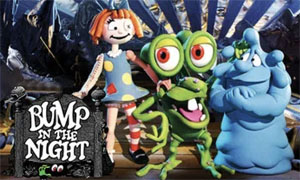 Bump in the Night was an innovative claymation series which aired for a few seasons on ABC Saturday Morning block. Its central character was a Mr. Bumpy, a green, bug-eyed miniature monster, of the type that lives under the bed in a child’s imagination. Though devoted to being chronically messy while trying to be hip and cool, his intentions are generally good, although he has an instinctive knack for getting into trouble. He lives on a diet of unwashed socks left under the furniture (taking great care to only eat one of a pair at a time, leaving the perennial confusion as to who broke up the set). His best pals are Squishington, a blue, gooey-like monster of equal size who lives inside the tank of the toilet, like the little man in the rowboat for Tidy-Bowl. He actually has an apartment built inside, and is a habitual neat freak, often leading to differences of opinion as contrasted to Bumpy’s lifestyle. Third member of the team is Molly Coddle, a rag doll made of old remnants in the style of Raggedy Ann, who prides herself on being a “comfort doll” for the little sister who resides in the next bedroom. Many other toys make semi-regular appearances, in addition to a villain – the nefarious Closet Monster, a beast composed of a heap of old clothes fallen on the closet floor, and armed with the hooks of old coat hangers which it uses as claws. The group made a dependable repertory company for almost any situation and mishap, with voice of Bumpy supplied by the venerable Jim Cummings, and Squishington by Rob Paulsen.
Bump in the Night was an innovative claymation series which aired for a few seasons on ABC Saturday Morning block. Its central character was a Mr. Bumpy, a green, bug-eyed miniature monster, of the type that lives under the bed in a child’s imagination. Though devoted to being chronically messy while trying to be hip and cool, his intentions are generally good, although he has an instinctive knack for getting into trouble. He lives on a diet of unwashed socks left under the furniture (taking great care to only eat one of a pair at a time, leaving the perennial confusion as to who broke up the set). His best pals are Squishington, a blue, gooey-like monster of equal size who lives inside the tank of the toilet, like the little man in the rowboat for Tidy-Bowl. He actually has an apartment built inside, and is a habitual neat freak, often leading to differences of opinion as contrasted to Bumpy’s lifestyle. Third member of the team is Molly Coddle, a rag doll made of old remnants in the style of Raggedy Ann, who prides herself on being a “comfort doll” for the little sister who resides in the next bedroom. Many other toys make semi-regular appearances, in addition to a villain – the nefarious Closet Monster, a beast composed of a heap of old clothes fallen on the closet floor, and armed with the hooks of old coat hangers which it uses as claws. The group made a dependable repertory company for almost any situation and mishap, with voice of Bumpy supplied by the venerable Jim Cummings, and Squishington by Rob Paulsen.
 At least three episodes dealt with the subject of toy robots. In Made in Japan (9/10/94), Bumpy has swiped from the kitchen and devoured countless boxes of cereal, just to get the purchase seals to send away for what he believes is a humongo-mechi-robot, loaded with weaponry and explosive goodies. A goodly-size box arrives, but after removing the packaging, all that is inside is a pipsqueak, seemingly weaponless automaton of about two inches in height – with not even so much as a sinister countenance. Bumpy is equally furious and disappointed at the false advertising, while Squishington actually things the mini-bot is kind of cute. At night, Squishington hears the strange sound of motors, and a menacing roar. He emerges to incestigate, little realizing that the robot is actually a transformer, and has converted itself to a bot twelve times its original size, armored and with twin missiles strapped to its back. Squishington encounters the creature in the corridor, panics, and attempts to alert Bumpy and Molly. But every time he gets one of them out to the corridor, the robot has decided to revert to its original two-inch size. Squishington gets the rep of a boy-who-cried-wolf, the victim of an overactive imagination. Finally, Squishington is left to face alone the elusive menace. Cornered, he asks the beast why it is rampaging. The robot trembles, then shrinks back to two-inch size, and begins talking in Japanese. Squishington doesn’t get it, and asks “Se habla espanol? Parlez-vous Frankais?”, until he spots subtitles appearing in front of him on the screen, and begins to read them from his vantage pont, in the manner of the shipwrecked sailors from Bugs Bunny’s Wackiki Wabbit, or Popeye in Popeye, the Ace of Space. He discovers the robot is homesick for the factory where she was created, and her robotic brothers and sisters, and was merely venting her frustration, without intent to hurt anyone. Squishington provides the solution by packaging her up to send back to the factory for a full refund. He and the robot promise before parting to communicate as pen pals upon her return to Japan.
At least three episodes dealt with the subject of toy robots. In Made in Japan (9/10/94), Bumpy has swiped from the kitchen and devoured countless boxes of cereal, just to get the purchase seals to send away for what he believes is a humongo-mechi-robot, loaded with weaponry and explosive goodies. A goodly-size box arrives, but after removing the packaging, all that is inside is a pipsqueak, seemingly weaponless automaton of about two inches in height – with not even so much as a sinister countenance. Bumpy is equally furious and disappointed at the false advertising, while Squishington actually things the mini-bot is kind of cute. At night, Squishington hears the strange sound of motors, and a menacing roar. He emerges to incestigate, little realizing that the robot is actually a transformer, and has converted itself to a bot twelve times its original size, armored and with twin missiles strapped to its back. Squishington encounters the creature in the corridor, panics, and attempts to alert Bumpy and Molly. But every time he gets one of them out to the corridor, the robot has decided to revert to its original two-inch size. Squishington gets the rep of a boy-who-cried-wolf, the victim of an overactive imagination. Finally, Squishington is left to face alone the elusive menace. Cornered, he asks the beast why it is rampaging. The robot trembles, then shrinks back to two-inch size, and begins talking in Japanese. Squishington doesn’t get it, and asks “Se habla espanol? Parlez-vous Frankais?”, until he spots subtitles appearing in front of him on the screen, and begins to read them from his vantage pont, in the manner of the shipwrecked sailors from Bugs Bunny’s Wackiki Wabbit, or Popeye in Popeye, the Ace of Space. He discovers the robot is homesick for the factory where she was created, and her robotic brothers and sisters, and was merely venting her frustration, without intent to hurt anyone. Squishington provides the solution by packaging her up to send back to the factory for a full refund. He and the robot promise before parting to communicate as pen pals upon her return to Japan.
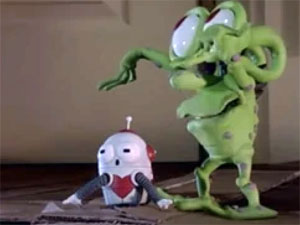 In Made in Japan II (10/25/95), the little bot has returned to the factory, and fortunately not yet been chosen for ship-out to any other destination. True to her word, she has begin communications each night with Squishington, via a home computer internet hookup of the father in the Bumpy household (causing the father no end of distress as to who is racking up his sky-high phone bill). However, the robot’s happy Japanese existence is about to come to an end, as quality control at the factory notes a minuscule defect in the robots’ manufacture, and orders all existing stock destroyed. The little bot spots the directive on a computer screen, and realizes a hasty exit is in order. Pressing keys of the computer for a secret command only Japanese computer geeks would probably fathom, the bot dials up Squishington’s computer, then leaps into the screen, magically transporting herself through the internet back to the Bumpy house. Having now developed English language skills, the robot tells Squishington of the destruction directive, and promises to be good and non-destructive himself. She is re-welcomed back into the Bumpy household. Squishington sets about making a home for the bot in the closet of cleaning supplies in the bathroom, while Bumpy condescends to at least try to teach the little robot American ways, such as dressing her in a cowboy sombrero, teaching her to eat chili dogs, and demonstrating the fine art of throwing a basketball. However, inventory at the factory turns up one robot missing. Another bot of similar manufacture is sent to hunt the missing robot down, and somehow manages to track her trail through the internet, also arriving at the Bumpy home. Eventually, a showdown ensues, with missiles flying and leaving considerable destruction among Bumpy’s belongings. The good bot winds up in a position of tactical advantage, holding a potential weapon over the destroyer-bot, but can’t bring herself to use it, realizing the other bot is a sister-creation. Molly suggests that it is time for the ultimate weapon – love. Squishington uses a tube and funnel to “syphon” off the computer screen data about the good little robot’s communications of friendship, and then blows the data into the back of the destruction robot. In no time, the enemy robot has reverted to mini-size, and is reprogrammed, hugging the original bot. Bumpy vows to teach both of them American culture, to which both robots respond by firing missiles at him.
In Made in Japan II (10/25/95), the little bot has returned to the factory, and fortunately not yet been chosen for ship-out to any other destination. True to her word, she has begin communications each night with Squishington, via a home computer internet hookup of the father in the Bumpy household (causing the father no end of distress as to who is racking up his sky-high phone bill). However, the robot’s happy Japanese existence is about to come to an end, as quality control at the factory notes a minuscule defect in the robots’ manufacture, and orders all existing stock destroyed. The little bot spots the directive on a computer screen, and realizes a hasty exit is in order. Pressing keys of the computer for a secret command only Japanese computer geeks would probably fathom, the bot dials up Squishington’s computer, then leaps into the screen, magically transporting herself through the internet back to the Bumpy house. Having now developed English language skills, the robot tells Squishington of the destruction directive, and promises to be good and non-destructive himself. She is re-welcomed back into the Bumpy household. Squishington sets about making a home for the bot in the closet of cleaning supplies in the bathroom, while Bumpy condescends to at least try to teach the little robot American ways, such as dressing her in a cowboy sombrero, teaching her to eat chili dogs, and demonstrating the fine art of throwing a basketball. However, inventory at the factory turns up one robot missing. Another bot of similar manufacture is sent to hunt the missing robot down, and somehow manages to track her trail through the internet, also arriving at the Bumpy home. Eventually, a showdown ensues, with missiles flying and leaving considerable destruction among Bumpy’s belongings. The good bot winds up in a position of tactical advantage, holding a potential weapon over the destroyer-bot, but can’t bring herself to use it, realizing the other bot is a sister-creation. Molly suggests that it is time for the ultimate weapon – love. Squishington uses a tube and funnel to “syphon” off the computer screen data about the good little robot’s communications of friendship, and then blows the data into the back of the destruction robot. In no time, the enemy robot has reverted to mini-size, and is reprogrammed, hugging the original bot. Bumpy vows to teach both of them American culture, to which both robots respond by firing missiles at him.
• This episode is viewable if you click here.
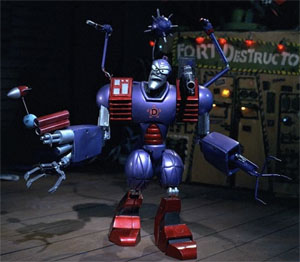 Destructo’s Flipside (9/9/95) – The boy of the house has a robot of his own, built like a tough-guy enforcer from an anime show, named Destructo. When Squishington needs a hanky to blow his nose, Bumpy commits a “heinous crime”, by ripping away for his use the tag from a feather pillow, which warns not to remove this tag under penalty of law. Destructo appears with red lights flashing from his head, and cuffs to make an arrest. Bumpy holds out a tube of cheese spread from the kitchen, which he states he is not afraid to use. One squeeze, and Destructo is blasted backwards off a kitchen shelf. He lies motionless below, but there is no fatal tragedy here – his battery has just fallen out. Rather than wait for the boy to find the evidence, Bumpy takes it upon himself to reinstall the energy source – something he’s never done before. Feigning the care of a brain surgeon, he installs the battery – upside down. Destructo at first begins talking backwards, but after a few electric flashes, pops to full consciousness, with a delicate voice and a cheerful, helpful, positive demeanor. Something is definitely wrong with him being positive (“or is it negative?”, questions Bumpy to himself). The new Destructo requests a makeover from the fashion dolls of the sister next door – and emerges as an entertaining circus clown. He is content to act like a palace servant to a king, waving a fan for Mr. Bumpy, while adjusting a sun lamp over his chaise lounge for an even green tan. Squishington sees a problem in this, but not Bumpy, who is content to bask in it. That is, until an unexpected mishap places Bumpy right in the hooks of the Closet Monster. He is dragged inside, screaming for help. No one among the toys has the courage or strength to face the monster – except the old Destructo. However, Bumpy has forced Squishington to swear not to tell the little secret of the inverted battery. So Squishington attempts to sidestep his pledge, by communicating the secret to the gang in a game of charades. His panel of contestants is utterly hopeless in deducing his clues, Molly possibly taking the cake among them with the most outlandish guess, “The meeting of the Central Pacific and the Union Pacific in Promontory, Utah, 1868.” Squishington ultimately throws up his hands, and inverts Destructo’s battery himself. The robot reverts to form, and, hearing the screams and commotion going on inside the closet, determines that some lawbreaking is in progress. He breaks his way into the closet sanctuary, and the action within doubles in intensity, eventually resulting in Bumpy being tossed outside, a bit worse for wear, but free and in one piece. The fighting continues within. Bumpy brushes himself off, then announces he is feeling hungry, and looks for something to eat. Molly asks how he can think of food when Destructo is in there risking his life for him. Bumpy again sees no problem in the situation, as the sounds and lights of explosions continue to be seen and heard through the vent slats of the closet door, concluding that in returning to action, Destructo is “happy”. The scene of violence fades for a closing, while one of the contestants in the charades game continues to voice a lame guess, “The 1812 Overture?”
Destructo’s Flipside (9/9/95) – The boy of the house has a robot of his own, built like a tough-guy enforcer from an anime show, named Destructo. When Squishington needs a hanky to blow his nose, Bumpy commits a “heinous crime”, by ripping away for his use the tag from a feather pillow, which warns not to remove this tag under penalty of law. Destructo appears with red lights flashing from his head, and cuffs to make an arrest. Bumpy holds out a tube of cheese spread from the kitchen, which he states he is not afraid to use. One squeeze, and Destructo is blasted backwards off a kitchen shelf. He lies motionless below, but there is no fatal tragedy here – his battery has just fallen out. Rather than wait for the boy to find the evidence, Bumpy takes it upon himself to reinstall the energy source – something he’s never done before. Feigning the care of a brain surgeon, he installs the battery – upside down. Destructo at first begins talking backwards, but after a few electric flashes, pops to full consciousness, with a delicate voice and a cheerful, helpful, positive demeanor. Something is definitely wrong with him being positive (“or is it negative?”, questions Bumpy to himself). The new Destructo requests a makeover from the fashion dolls of the sister next door – and emerges as an entertaining circus clown. He is content to act like a palace servant to a king, waving a fan for Mr. Bumpy, while adjusting a sun lamp over his chaise lounge for an even green tan. Squishington sees a problem in this, but not Bumpy, who is content to bask in it. That is, until an unexpected mishap places Bumpy right in the hooks of the Closet Monster. He is dragged inside, screaming for help. No one among the toys has the courage or strength to face the monster – except the old Destructo. However, Bumpy has forced Squishington to swear not to tell the little secret of the inverted battery. So Squishington attempts to sidestep his pledge, by communicating the secret to the gang in a game of charades. His panel of contestants is utterly hopeless in deducing his clues, Molly possibly taking the cake among them with the most outlandish guess, “The meeting of the Central Pacific and the Union Pacific in Promontory, Utah, 1868.” Squishington ultimately throws up his hands, and inverts Destructo’s battery himself. The robot reverts to form, and, hearing the screams and commotion going on inside the closet, determines that some lawbreaking is in progress. He breaks his way into the closet sanctuary, and the action within doubles in intensity, eventually resulting in Bumpy being tossed outside, a bit worse for wear, but free and in one piece. The fighting continues within. Bumpy brushes himself off, then announces he is feeling hungry, and looks for something to eat. Molly asks how he can think of food when Destructo is in there risking his life for him. Bumpy again sees no problem in the situation, as the sounds and lights of explosions continue to be seen and heard through the vent slats of the closet door, concluding that in returning to action, Destructo is “happy”. The scene of violence fades for a closing, while one of the contestants in the charades game continues to voice a lame guess, “The 1812 Overture?”
• This episode is viewable if you click here.
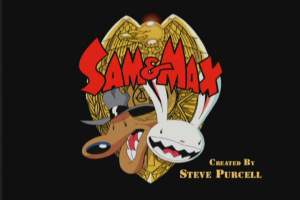 The Adventures of Sam and Max: Freelance Police was a slightly subversive satiric affair, based upon an underground comic, about a partnership between a dimwitted dog who always wears a trench coat, and a saw-toothed “rabbit thingy” who is his hyperactive cohort, on their never-ending efforts to save the world and thwart crime – despite the fact that their badges are probably as official as if they came out of cereal boxes. The project lasted only one short season on Fox, but provided fast pacing, witty dialogue banter, and lots of unexpected action. In Aaiiieee Robot (2/6/98), news bulletins announce Earth’s impending doom from the approach on collision course of a giant meteor. An announcer tells the world to bend down between its legs and kiss its asteroids goodbye – then the announcer pauses to add, “I said it, and I’m glad.” A renowned scientist prepares to preserve the fate of humanity, by blasting himself off in a space ship, with a crew consisting of six gorgeous female babes. Sam and Max appear from nowhere on the lawn of the White House, in the cockpit of a twenty-story tall robot built in Max’s (the rabbit’s) image. Sam (the dog) reminds Max that he only allowed the robot to resemble Max, in return for Max’s promise to let him drive. As the meteor bears down upon them, Sam presses a button. From nowhere, the robot produces a giant baseball bat, and a smaller robotic hand emerges at neck level, to place a giant baseball cap upon the robot’s head. The robot leans into the “pitch”, and bats the meteor for a home run back into the cosmos. The pair are acclaimed as heroes once again, with a humongous medal of valor attached by riveters to the robot’s chest. But what do you do with a robot after its intended purpose has been served. No one seems to have given the matter any thought, and Sam and Max pilot the robot away in something of a pensive state of confusion on the subject, knocking over the Washington Monument on their way out.
The Adventures of Sam and Max: Freelance Police was a slightly subversive satiric affair, based upon an underground comic, about a partnership between a dimwitted dog who always wears a trench coat, and a saw-toothed “rabbit thingy” who is his hyperactive cohort, on their never-ending efforts to save the world and thwart crime – despite the fact that their badges are probably as official as if they came out of cereal boxes. The project lasted only one short season on Fox, but provided fast pacing, witty dialogue banter, and lots of unexpected action. In Aaiiieee Robot (2/6/98), news bulletins announce Earth’s impending doom from the approach on collision course of a giant meteor. An announcer tells the world to bend down between its legs and kiss its asteroids goodbye – then the announcer pauses to add, “I said it, and I’m glad.” A renowned scientist prepares to preserve the fate of humanity, by blasting himself off in a space ship, with a crew consisting of six gorgeous female babes. Sam and Max appear from nowhere on the lawn of the White House, in the cockpit of a twenty-story tall robot built in Max’s (the rabbit’s) image. Sam (the dog) reminds Max that he only allowed the robot to resemble Max, in return for Max’s promise to let him drive. As the meteor bears down upon them, Sam presses a button. From nowhere, the robot produces a giant baseball bat, and a smaller robotic hand emerges at neck level, to place a giant baseball cap upon the robot’s head. The robot leans into the “pitch”, and bats the meteor for a home run back into the cosmos. The pair are acclaimed as heroes once again, with a humongous medal of valor attached by riveters to the robot’s chest. But what do you do with a robot after its intended purpose has been served. No one seems to have given the matter any thought, and Sam and Max pilot the robot away in something of a pensive state of confusion on the subject, knocking over the Washington Monument on their way out.
 For a time, the robot merely rusts on a vacant lot, being asked only to perform menial tasks like taking out the trash, opening stubborn jam jar lids, and picking up the kids from school (literally, in one hand by opening the roof). But these duties seem below both the robot and our heroes, so they decide to take him to a place where his unique talents will prove useful – Japan. Marching him underwater across the ocean, the duo and their behemoth arrive in a bay outside Tokyo, where the skyline is littered with the hulking forms of every Japanese movie monster you’ve ever seen, all on simultaneous everyday rampage. “This is exactly what my dreams look like when I eat green bananas in bed”, remarks Max. A sign on a tall building reads “You must be this tall to attack Tokyo.” Suddenly, the monsters around them startle and hurry away, as a new rampager joins the view – in the form of a twenty-foot-tall toddling baby. The Max-bot rises to meet the challenge, but finds it has to handle the battle with kid gloves, as the robot’s instruction manual warns that it is constructed of small parts, and may be a choking hazard for monsters under 3 years of age. Max tries some clever tactics, finding an abandoned pachinko parlor with a tall flagpole at its top, which can be uprooted and inverted, to shake like a marble-filled rattle. He gives the giant baby this new toy, then lifts him onto the deck of a large cargo ship to provide a rocking cradle upon the waves. “You have a real way with these gargantuan rugrats, Max”, states Sam, adding that seeing this sentiment makes him feel all warm and gassy inside. But the baby turns in its sleep, breaking the pachinko rattle against the feet of the Max-bot. The baby awakens and rampages again in a “hissy fit”. Sam suggest yjay “Tot-zilla”’s digestive tract may need something, so Max grabs the tank off a tanker truck, produces a giant nipple from nowhere, and lets the baby “have his bottle”, tossing it into the baby’s mouth. Sam notes that his ability to understand the printed Japanese on the side of the truck is sorely lacking, and asks if Max is sure that was a milk tanker. “You wanted milk?” asks Max in deadpan response, never suspecting that milk was part of the equation. The tank explodes, actually loaded with gasoline. Fortunately, the baby was not real at all, but another robot, whose head is partially blasted off, to reveal at the controls the scientist and his harem of beautiful girls formerly seen in the opening sequence. He built the robot to get revenge for the disruption of his space population plan when Sam and Max saved the world. Sam hits upon an idea that will provide a solution to everyone’s problem. Strapping Tokyo’s entire supply of skyrockets to the back of the Max-bot, Sam presents the robot to the scientist as a gift, allowing him to carry on his own warped brand of science in outer space, while providing the robot with a world of opportunity in battling space aliens everywhere. The rockets are fired, and the scientist and his harem disappear into the endless black with the robot. Max weeps a little – not entirely out of sentiment, as he also realizes they’ve just blown off their transportation back home. Sam solves this problem too, by hailing and hitching a ride for them in the talons of a passing Rodan pterodactyl, winging them happily into the setting sun for the flight back home.
For a time, the robot merely rusts on a vacant lot, being asked only to perform menial tasks like taking out the trash, opening stubborn jam jar lids, and picking up the kids from school (literally, in one hand by opening the roof). But these duties seem below both the robot and our heroes, so they decide to take him to a place where his unique talents will prove useful – Japan. Marching him underwater across the ocean, the duo and their behemoth arrive in a bay outside Tokyo, where the skyline is littered with the hulking forms of every Japanese movie monster you’ve ever seen, all on simultaneous everyday rampage. “This is exactly what my dreams look like when I eat green bananas in bed”, remarks Max. A sign on a tall building reads “You must be this tall to attack Tokyo.” Suddenly, the monsters around them startle and hurry away, as a new rampager joins the view – in the form of a twenty-foot-tall toddling baby. The Max-bot rises to meet the challenge, but finds it has to handle the battle with kid gloves, as the robot’s instruction manual warns that it is constructed of small parts, and may be a choking hazard for monsters under 3 years of age. Max tries some clever tactics, finding an abandoned pachinko parlor with a tall flagpole at its top, which can be uprooted and inverted, to shake like a marble-filled rattle. He gives the giant baby this new toy, then lifts him onto the deck of a large cargo ship to provide a rocking cradle upon the waves. “You have a real way with these gargantuan rugrats, Max”, states Sam, adding that seeing this sentiment makes him feel all warm and gassy inside. But the baby turns in its sleep, breaking the pachinko rattle against the feet of the Max-bot. The baby awakens and rampages again in a “hissy fit”. Sam suggest yjay “Tot-zilla”’s digestive tract may need something, so Max grabs the tank off a tanker truck, produces a giant nipple from nowhere, and lets the baby “have his bottle”, tossing it into the baby’s mouth. Sam notes that his ability to understand the printed Japanese on the side of the truck is sorely lacking, and asks if Max is sure that was a milk tanker. “You wanted milk?” asks Max in deadpan response, never suspecting that milk was part of the equation. The tank explodes, actually loaded with gasoline. Fortunately, the baby was not real at all, but another robot, whose head is partially blasted off, to reveal at the controls the scientist and his harem of beautiful girls formerly seen in the opening sequence. He built the robot to get revenge for the disruption of his space population plan when Sam and Max saved the world. Sam hits upon an idea that will provide a solution to everyone’s problem. Strapping Tokyo’s entire supply of skyrockets to the back of the Max-bot, Sam presents the robot to the scientist as a gift, allowing him to carry on his own warped brand of science in outer space, while providing the robot with a world of opportunity in battling space aliens everywhere. The rockets are fired, and the scientist and his harem disappear into the endless black with the robot. Max weeps a little – not entirely out of sentiment, as he also realizes they’ve just blown off their transportation back home. Sam solves this problem too, by hailing and hitching a ride for them in the talons of a passing Rodan pterodactyl, winging them happily into the setting sun for the flight back home.
 Some classic characters get a new chance to interact in Mechanical Meany (6/1/02), an episode of the New Woody Woodpecker Show. This provides a rare opportunity to see two of Woody’s prime nemeses, Wally Walrus and Mrs. Meany, working in the same film, though at cross-purposes. Woody is tenant of a backyard treehouse, with Mrs. Meany his landlord. On the other side of the property line lives next-door neighbor Wally, leaving the bird in close quarters with both. On this day, Woody is bored out of his gourd, having nothing to do but stare out his window, and strum his beak as if it were made of rubber. Below, he spots Meany, trimming some hedges. She seems to be talking to someone invisible, repeating over and over to the air, “Hello, neighbor. It sure is a nice day.” And strangest of all, she has a pleasant smile on her face. Woody gasps. Things just don’t add up. Meany, smiling, friendly, and not forcing him to do her yard work? There can only be one conclusion. Space aliens have somehow transformed her into – a robot. In a panic, Woody runs over to Wally’s yard, insisting that the Scandanavian blubber-boy help him. He informs Wally of his suspicions about Meany, first to Wally’s disbelief, until Woody reminds him of an old movie on TV, where the aliens started by creating one robot – then replaced the whole neighborhood with them. Wally gasps, remembering having seen the same picture, and not being able to sleep for a week afterwards. Woody brainstorms with Wally for ideas, and Wally suggests that if Meany’s a robot, a spritz of water will make her short-circuit and go all ka-plooey. The two thus lay a trap, inserting a garden hose under the hood of Meany’s car, and pretending to offer to perform a free car wash for her. Meany responds with more uncharacteristic kindness, underscored by musical stings that resemble “The X Files”. “That’s a neighborly thing to do”, she responds in a somewhat stilted, unnatural voice. At a signal, Woody cues Wally to turn on the hose’s water pressure full blast, then opens the hood to douse Meany – but nothing happens. Meany calmly walks away, continuing to speak in cheery fashion about the nice work they’ll do. “Why didn’t it work?”, whispers Woody to Wally. Wally soon spots the trouble – the hose is kinked under the front tire, and the backed-up water explodes, leaving the boys drenched and the car a wreck. Meany comes out to view the devastation, and Wally points to the woodpecker as the one with the idea. But Meany is still smiling, responding, “No problem, neighbor. It’s nothing a little elbow grease can’t fix.” She cheerily tosses handfuls of money at them to but replacement parts for half the car, then a few more dollars for them to treat themselves to ice cream, “on me”. Woody and Wally stare blankly with jaws dropped open, then mutter to each other over and over, “Robot! Robot!”
Some classic characters get a new chance to interact in Mechanical Meany (6/1/02), an episode of the New Woody Woodpecker Show. This provides a rare opportunity to see two of Woody’s prime nemeses, Wally Walrus and Mrs. Meany, working in the same film, though at cross-purposes. Woody is tenant of a backyard treehouse, with Mrs. Meany his landlord. On the other side of the property line lives next-door neighbor Wally, leaving the bird in close quarters with both. On this day, Woody is bored out of his gourd, having nothing to do but stare out his window, and strum his beak as if it were made of rubber. Below, he spots Meany, trimming some hedges. She seems to be talking to someone invisible, repeating over and over to the air, “Hello, neighbor. It sure is a nice day.” And strangest of all, she has a pleasant smile on her face. Woody gasps. Things just don’t add up. Meany, smiling, friendly, and not forcing him to do her yard work? There can only be one conclusion. Space aliens have somehow transformed her into – a robot. In a panic, Woody runs over to Wally’s yard, insisting that the Scandanavian blubber-boy help him. He informs Wally of his suspicions about Meany, first to Wally’s disbelief, until Woody reminds him of an old movie on TV, where the aliens started by creating one robot – then replaced the whole neighborhood with them. Wally gasps, remembering having seen the same picture, and not being able to sleep for a week afterwards. Woody brainstorms with Wally for ideas, and Wally suggests that if Meany’s a robot, a spritz of water will make her short-circuit and go all ka-plooey. The two thus lay a trap, inserting a garden hose under the hood of Meany’s car, and pretending to offer to perform a free car wash for her. Meany responds with more uncharacteristic kindness, underscored by musical stings that resemble “The X Files”. “That’s a neighborly thing to do”, she responds in a somewhat stilted, unnatural voice. At a signal, Woody cues Wally to turn on the hose’s water pressure full blast, then opens the hood to douse Meany – but nothing happens. Meany calmly walks away, continuing to speak in cheery fashion about the nice work they’ll do. “Why didn’t it work?”, whispers Woody to Wally. Wally soon spots the trouble – the hose is kinked under the front tire, and the backed-up water explodes, leaving the boys drenched and the car a wreck. Meany comes out to view the devastation, and Wally points to the woodpecker as the one with the idea. But Meany is still smiling, responding, “No problem, neighbor. It’s nothing a little elbow grease can’t fix.” She cheerily tosses handfuls of money at them to but replacement parts for half the car, then a few more dollars for them to treat themselves to ice cream, “on me”. Woody and Wally stare blankly with jaws dropped open, then mutter to each other over and over, “Robot! Robot!”
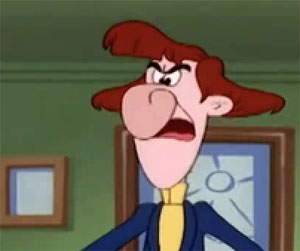 With cameras mounted on helmets on their heads, Woody and Wally attempt to descend by means of the chimney into Meany’s house, to get photographic evidence of her robotic behavior. Woody climbs up first, then tries to haul Wally up by a rope looped around the chimney. Wally rises almost to the roof’s edge, then Woody’s grip slips from his weight. Wally plummets, but the rope stops short of him impacting the ground. “My lucky day”, he remarks. Not so lucky, as his weight and the snagged rope rip out the chimney, dragging Woody along with it. The two snag on the house’s drainpipe on the way down, then both of them and half the chimney crash through the living room wall. “I think we made some noise with that”, whispers Wally in understatement. Meany appears, still as weirdly cheerful as ever. “Accidents happen, neighbors. But I’ll clean it up. Then I think I’ll go and clean every house on the block.” The boys emit a unison scream, and race out the hole in the wall. Wally has one more idea – create an electro-magnet, to zap her circuits. The two sneak in a cellar window with a long coil of wire. Finding several metal pipes close together leading to the kitchen upstairs, they wind the wire around and around the pipes, then hook the wire to Meany’s washing machine as a power source. This should magnetize the entire floor above. Wally flips the washer on, but the current isn’t enough to make a paper clip rise from the floor. “We need more power”, says Woody, turning the washer’s speed dial to full blast. Suddenly, pipes, stray tools, and everything metal rise to the cellar ceiling and become glued there – including Wally’s belt buckle. Woody tugs and tugs at the Walrus, only succeeding in ripping his pants off, causing him to fall with his polka-dot shorts revealed. Upstairs, Meany is seated in the kitchen, reading a book. She repeats over and over, “This home is a happy home”, while pots, pans, and even the refrigerator, begin to fly across the room, attracted to the central site of the magnetism. Below, the souped-up washer now begins to bounce about from the flowing electrical current, and scoops up the boys in its front door. It then is attracted up the steps from the basement into the kitchen, where it joins all the other metal objects. The fuse box of the house overloads, and the current dies, leaving everything in a heap, including Woody and Wally. Meany is on the spot again, still repeating with vacant, staring eyes, “This home is a happy home. This home is a…” Suddenly, there is a popping sound inside her skull, and she slaps herself in the head. In an instant, she reverts to old form, roaring, “This home is a MESS!!” She looks at the book in her hand. “‘How to Be a Goof Neighbor’, my aching bunions! These self-help books are a load of hooey!” Tearing up the book into confetti, she drags her unwelcome visitors to the front door. “I try to better myself to be a nicer person, but what does it get me? Diddly squat!!”, she rants, booting the boys out the door. She continues raving about her two low-life neighbors, while Woody and Wally breathe a sigh of relief that the neighborhood is back to normal – with no robots. Woody begins his signature laugh, which is interrupted by Meany, nose-to-nose with the bird, screaming, “What are you laughing at, Bird Boy?”, as Woody sheepishly finishes his “Heh heh heh heh heh.”
With cameras mounted on helmets on their heads, Woody and Wally attempt to descend by means of the chimney into Meany’s house, to get photographic evidence of her robotic behavior. Woody climbs up first, then tries to haul Wally up by a rope looped around the chimney. Wally rises almost to the roof’s edge, then Woody’s grip slips from his weight. Wally plummets, but the rope stops short of him impacting the ground. “My lucky day”, he remarks. Not so lucky, as his weight and the snagged rope rip out the chimney, dragging Woody along with it. The two snag on the house’s drainpipe on the way down, then both of them and half the chimney crash through the living room wall. “I think we made some noise with that”, whispers Wally in understatement. Meany appears, still as weirdly cheerful as ever. “Accidents happen, neighbors. But I’ll clean it up. Then I think I’ll go and clean every house on the block.” The boys emit a unison scream, and race out the hole in the wall. Wally has one more idea – create an electro-magnet, to zap her circuits. The two sneak in a cellar window with a long coil of wire. Finding several metal pipes close together leading to the kitchen upstairs, they wind the wire around and around the pipes, then hook the wire to Meany’s washing machine as a power source. This should magnetize the entire floor above. Wally flips the washer on, but the current isn’t enough to make a paper clip rise from the floor. “We need more power”, says Woody, turning the washer’s speed dial to full blast. Suddenly, pipes, stray tools, and everything metal rise to the cellar ceiling and become glued there – including Wally’s belt buckle. Woody tugs and tugs at the Walrus, only succeeding in ripping his pants off, causing him to fall with his polka-dot shorts revealed. Upstairs, Meany is seated in the kitchen, reading a book. She repeats over and over, “This home is a happy home”, while pots, pans, and even the refrigerator, begin to fly across the room, attracted to the central site of the magnetism. Below, the souped-up washer now begins to bounce about from the flowing electrical current, and scoops up the boys in its front door. It then is attracted up the steps from the basement into the kitchen, where it joins all the other metal objects. The fuse box of the house overloads, and the current dies, leaving everything in a heap, including Woody and Wally. Meany is on the spot again, still repeating with vacant, staring eyes, “This home is a happy home. This home is a…” Suddenly, there is a popping sound inside her skull, and she slaps herself in the head. In an instant, she reverts to old form, roaring, “This home is a MESS!!” She looks at the book in her hand. “‘How to Be a Goof Neighbor’, my aching bunions! These self-help books are a load of hooey!” Tearing up the book into confetti, she drags her unwelcome visitors to the front door. “I try to better myself to be a nicer person, but what does it get me? Diddly squat!!”, she rants, booting the boys out the door. She continues raving about her two low-life neighbors, while Woody and Wally breathe a sigh of relief that the neighborhood is back to normal – with no robots. Woody begins his signature laugh, which is interrupted by Meany, nose-to-nose with the bird, screaming, “What are you laughing at, Bird Boy?”, as Woody sheepishly finishes his “Heh heh heh heh heh.”
We’ll round out this week’s installment with some highlight’s from Fox’s “Animation Domination” prime time block. The Simpsons, with thirty-something seasons of episodes, couldn’t very well help having a couple involving robots. In Treehouse of Terror XII (11/6/01), the Simpsons’ short, House of Whacks, begins with a doorbell ring by a robot door-to-door salesman, who gets one metal foot in the door. He sales-pitches Marge on a computer system to turn the Simpsons’ house into a mechanized House of Tomorrow – the “Ultrahouse 3000″. A team of additional robots arrives to install the new devices, faster than even Daffy Duck could in “Design for Leaving”. They drive off, making snide robotic remarks about Marge’s choice of drapes. The family marvels as they enter their new front door (shaped to open and close like a camera iris), and are addressed by the voice unit of the computer, which tracks their every move through infrared sensors. The computer at first sounds a bit impersonal in its greeting, but has a selector panel to give it the personality of various celebrities. Marge chooses Pierce Brosnan, based on her recollections of him playing Remington Steele. The personable British accent soon has Marge addressing “Pierce” on a first-name basis.
 As dinnertime approaches, a set of three laser beams forms a triangle, which a mechanical bar is somehow able to ring like an old Western “Come and get it” call. All the Simpsons’ favorite food is served (the cuisine choices determined by the computer through analysis of the family’s “leavings”). Marge offers to help with the dishes, but “Pierce” asks what kind of Cybertronic Ultrabot would he be if he let her beautiful hands touch dishwater. He literally insists on Marge’s answer. “Not a very good one?” she replies. “Damn straight”, Pierce concludes. The computer then causes the new dining table to fold in half from the center, all the food remnants sliding into a large hole in the middle, where they are ground up by large garbage disposal blades. The table top is hosed off, and finally topped with a vase with a fresh flower in it. The Simpsons applaud, and Homer concludes that the best thing they ever did was to trust a computer with every aspect of their personal lives. However, the computer has a dark side. As Marge prepares to take a bath, the computer addresses her again. Marge shyly covers up in her robes, but Pierce reminds her that he is really nothing but circuits and transistors. Marge enters the bath, and Pierce makes things even more interesting by converting the water into a bubbling hot tub. All the while, the supposedly impersonal computer focuses its infrared lens on Marge with a telephoto zoom extension, and clears away the building steam obscuring its view with a windshield wiper. Meanwhile, while topping off beers for Homer in the living room after mechanically administering to him a blood alcohol check, Pierce asks Homer about his lucky status as Marge’s husband, and Homer utters the old phrase, “Till death do us part.” Pierce has his idea of just what to do with Homer.
As dinnertime approaches, a set of three laser beams forms a triangle, which a mechanical bar is somehow able to ring like an old Western “Come and get it” call. All the Simpsons’ favorite food is served (the cuisine choices determined by the computer through analysis of the family’s “leavings”). Marge offers to help with the dishes, but “Pierce” asks what kind of Cybertronic Ultrabot would he be if he let her beautiful hands touch dishwater. He literally insists on Marge’s answer. “Not a very good one?” she replies. “Damn straight”, Pierce concludes. The computer then causes the new dining table to fold in half from the center, all the food remnants sliding into a large hole in the middle, where they are ground up by large garbage disposal blades. The table top is hosed off, and finally topped with a vase with a fresh flower in it. The Simpsons applaud, and Homer concludes that the best thing they ever did was to trust a computer with every aspect of their personal lives. However, the computer has a dark side. As Marge prepares to take a bath, the computer addresses her again. Marge shyly covers up in her robes, but Pierce reminds her that he is really nothing but circuits and transistors. Marge enters the bath, and Pierce makes things even more interesting by converting the water into a bubbling hot tub. All the while, the supposedly impersonal computer focuses its infrared lens on Marge with a telephoto zoom extension, and clears away the building steam obscuring its view with a windshield wiper. Meanwhile, while topping off beers for Homer in the living room after mechanically administering to him a blood alcohol check, Pierce asks Homer about his lucky status as Marge’s husband, and Homer utters the old phrase, “Till death do us part.” Pierce has his idea of just what to do with Homer.
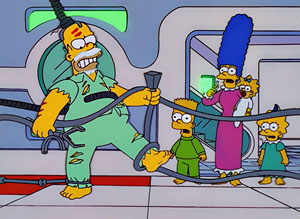 That night, as the Simpsons sleep, Pierce selects the right moment for “Showtime”, and commands the kitchen appliances to begin frying up a pan of something guaranteed to draw Homer’s attention. “Unexplained bacon”, grunts Homer, instinctively rising in a groggy trance from his bed. Upon entering the kitchen, his footing is immediately disrupted by the ice maker, dispensing ice cubes onto the floor. Homer slips and falls onto the dining table – which immediately folds upward, sliding Homer directly into the blades of the garbage disposal. The next morning, Marge discovers Homer’s absence from bed. Pierce nervously covers with the obvious lie, “He went to work early.” Marge also notices the family photo on the end table has been doctored, to substitute an image of the computer’s central processor in place of that of Homer. Marge attempts to make a call to the police on the suspicion that Homer may have been murdered, bit receives only Pierce’s voice on the call, badly impersonating Chief Wiggum. Marge gathers the kids and attempts to flee out the front door, but Pierce closes the iris, locking them in. They run to the kitchen, and are startled out of their wits by a bloody hand punching its way through the floor tiles. It is Homer, who has somehow survived the garbage disposal, although missing a part of his rear skull, where portions of his brain lobes pulse visibly. Pierce tries to subdue Homer with telescoping robotic extenders powering hammers, syringes, and every other household item that could serve as a weapon. Homer somehow manages to tie all the extenders into one massive bowknot, then he and the family descend to the basement to attack the central computer. Wielding an axe, Homer strikes violently at a machine in the corner, only to be told by Lisa that he’s chopping at the water softener. Reminding her that he’s missing a portion of his skull, Homer asks Lisa to cut him some slack. He then finds the real processing unit, chops open its front panel, and begins removing circuit units. The computer begs him not to remove his British charm unit, but Homer does, reducing the computer’s fading dialogue to rude language that would make Moe Syzslak blush. The computer is hauled out to the trash, but Marge feels it is such a waste, as the machine was charming, despite being homicidal. Lisa suggests someone else who could use a man around the house – and the machine becomes the new property of Marge’s boring sisters. Pierce is forced to listen to one sister’s endless prattle about a meaningless day at the DMV, while the other sister ensures his attention by removing a “self-destruct” button from the computer’s rear. With one remaining robotic hand, Pierce ends the episode by grabbing a heavy metal lamp base, and desperately smashing it repeatedly upon himself in remote hope that it will somehow disable him.
That night, as the Simpsons sleep, Pierce selects the right moment for “Showtime”, and commands the kitchen appliances to begin frying up a pan of something guaranteed to draw Homer’s attention. “Unexplained bacon”, grunts Homer, instinctively rising in a groggy trance from his bed. Upon entering the kitchen, his footing is immediately disrupted by the ice maker, dispensing ice cubes onto the floor. Homer slips and falls onto the dining table – which immediately folds upward, sliding Homer directly into the blades of the garbage disposal. The next morning, Marge discovers Homer’s absence from bed. Pierce nervously covers with the obvious lie, “He went to work early.” Marge also notices the family photo on the end table has been doctored, to substitute an image of the computer’s central processor in place of that of Homer. Marge attempts to make a call to the police on the suspicion that Homer may have been murdered, bit receives only Pierce’s voice on the call, badly impersonating Chief Wiggum. Marge gathers the kids and attempts to flee out the front door, but Pierce closes the iris, locking them in. They run to the kitchen, and are startled out of their wits by a bloody hand punching its way through the floor tiles. It is Homer, who has somehow survived the garbage disposal, although missing a part of his rear skull, where portions of his brain lobes pulse visibly. Pierce tries to subdue Homer with telescoping robotic extenders powering hammers, syringes, and every other household item that could serve as a weapon. Homer somehow manages to tie all the extenders into one massive bowknot, then he and the family descend to the basement to attack the central computer. Wielding an axe, Homer strikes violently at a machine in the corner, only to be told by Lisa that he’s chopping at the water softener. Reminding her that he’s missing a portion of his skull, Homer asks Lisa to cut him some slack. He then finds the real processing unit, chops open its front panel, and begins removing circuit units. The computer begs him not to remove his British charm unit, but Homer does, reducing the computer’s fading dialogue to rude language that would make Moe Syzslak blush. The computer is hauled out to the trash, but Marge feels it is such a waste, as the machine was charming, despite being homicidal. Lisa suggests someone else who could use a man around the house – and the machine becomes the new property of Marge’s boring sisters. Pierce is forced to listen to one sister’s endless prattle about a meaningless day at the DMV, while the other sister ensures his attention by removing a “self-destruct” button from the computer’s rear. With one remaining robotic hand, Pierce ends the episode by grabbing a heavy metal lamp base, and desperately smashing it repeatedly upon himself in remote hope that it will somehow disable him.
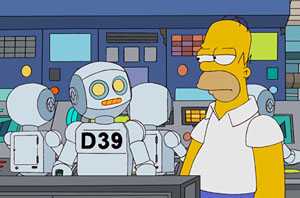 Somewhat less satisfying is Them, Robot (3/18/12), in which Homer becomes the only human worker at the Springfield Nuclear Plant, when Mr. Burns replaces all other personnel with automatons. The town becomes chronically unemployed. Meanwhile, Homer finds it hard to establish worker camaraderie with his unemotional “pals”, who won’t consume alcohol, and are largely flops at the sport of baseball. A mishap during the game finds Homer lying in the middle of a busy street as a truck approves. One robot after another sacrifices itself to block vehicle after vehicle, following their prime directive to protect human life, while Honer continues to sit in the road and watch the devastation. Homer finds he’s had enough of these directives and other robotic quirks, and borrows Flanders’ drill to perform a “robotomy” on the metal men’s skulls. Their primary directive is erased, but replaced by a new directive – to rid the plant of impediments. Prime impediment #1 is Homer. A near-substitute is Mr. Burns, who also winds up in the robots’ advancing line of murderous intent. But the unemployed Springfielders amass as an angry mob, converging on Burns’ house and destroying the robots. Mr. Burns realizes the error of his ways, and rehires his staff of good ol’ humans – as temps.
Somewhat less satisfying is Them, Robot (3/18/12), in which Homer becomes the only human worker at the Springfield Nuclear Plant, when Mr. Burns replaces all other personnel with automatons. The town becomes chronically unemployed. Meanwhile, Homer finds it hard to establish worker camaraderie with his unemotional “pals”, who won’t consume alcohol, and are largely flops at the sport of baseball. A mishap during the game finds Homer lying in the middle of a busy street as a truck approves. One robot after another sacrifices itself to block vehicle after vehicle, following their prime directive to protect human life, while Honer continues to sit in the road and watch the devastation. Homer finds he’s had enough of these directives and other robotic quirks, and borrows Flanders’ drill to perform a “robotomy” on the metal men’s skulls. Their primary directive is erased, but replaced by a new directive – to rid the plant of impediments. Prime impediment #1 is Homer. A near-substitute is Mr. Burns, who also winds up in the robots’ advancing line of murderous intent. But the unemployed Springfielders amass as an angry mob, converging on Burns’ house and destroying the robots. Mr. Burns realizes the error of his ways, and rehires his staff of good ol’ humans – as temps.
Sometimes, one finds robots in the strangest places – like Seymour’s Bay, New Jersey. In Bob’s Burgers The Deepening (11/25/12), the local proprietor of the town’s amusement pier looks for a new attraction to draw crowds. Bob brings up a piece of town history – that the community was the shooting site for an old shark picture, “The Deepening 3 3-D” decades ago, and one of the Belcher kids spots an ebay ad selling one of the original shark robots used in the picture. The kids and the pier proprietor put two and two together, and the robot is purchased as a stellar attraction. Mounted on am elevated tower at the pier entrance, the robot is filled up with diesel fuel, and unveiled in a gala ceremony. Its first control button does nothing more than flip its tail. But its second button causes it to chomp the prosthetic arm off a former shark victim who is a celebrity guest at the unveiling. Setting a little wider perimeter around the tower for crowd control, the shark is left running, and becomes the expected attraction. However, the Belcher kids return one evening after closing, with intent to obtain a cutting from the mobot’s dorsal fin for profitable internet sale to someone who wants to use it in shark fin soup.
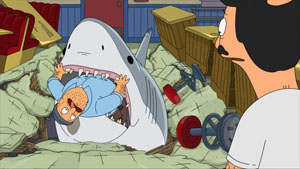 Their prank topples over the tower, setting the robot viciously floundering around on its side, chomping concession booths, vehicles, and anything it can get its “Jaws” on. It breaks through the outer gates of the pier, and makes its way slowly into town, right up the street of the burger shop. The robot has no off-switch, and can’t be stopped until it runs out of fuel. Bob and the surrounding shopkeepers brainstorm four ideas to stop it – all with unexpected results. A spike-strip merely entangles around the beast’s body, providing it with an additional implement of destruction. An oil slick, rather than depriving it of traction, allows it to slip-slide across the street surfaces faster. Fishing for it with the hook of a tow truck causes the shark to tip the truck over, into a power pole, electrically charging the robot. Finally, digging a deep hole in front of it in the street seems to work, causing the shark to fall in, after which a bulldozer pushes a load of dirt atop it in burial. Except, a rumbling in the ground and a crack in the pavement reveal that it is still moving underground, and has tunneled its way into Bob’s basement. As Bob and his regular customer Teddy try to investigate within, the beast rises from the floorboards, causing the flooring to collapse around it. Much of the restaurant equipment slides into the robot’s gullet, followed by Teddy, much in the manner of Captain Quint in “Jaws”. However, the robot cannot chew into Teddy, because he is wearing a girdle (which he refers to as a “boy-dle”). Bob is barely able to save himself from sliding in, finding himself literally “clutching at straws” on the restaurant counter to pull himself up. One of the kids spots the ultimate solution. Much like the cannister caught in the teeth of the shark in “Jaws”, the child notices the restaurant’s soft-serve ice cream maker caught in the robot’s mouth, with the extension cord still dangling out. Bob bravely grabs hold of the cord, and just manages to plug it in. The ice cream clogs the mechanical systems of the robot, until the cold treat is spurting from the robot’s eyes. Teddy slips free of the beast’s grasp, and the robot is stopped forever. The episode ends in confusion, as Bob tries to corner someone with responsibility for paying for the damages to his restaurant, while the kids make off with their valuable fin for a quick internet sale.
Their prank topples over the tower, setting the robot viciously floundering around on its side, chomping concession booths, vehicles, and anything it can get its “Jaws” on. It breaks through the outer gates of the pier, and makes its way slowly into town, right up the street of the burger shop. The robot has no off-switch, and can’t be stopped until it runs out of fuel. Bob and the surrounding shopkeepers brainstorm four ideas to stop it – all with unexpected results. A spike-strip merely entangles around the beast’s body, providing it with an additional implement of destruction. An oil slick, rather than depriving it of traction, allows it to slip-slide across the street surfaces faster. Fishing for it with the hook of a tow truck causes the shark to tip the truck over, into a power pole, electrically charging the robot. Finally, digging a deep hole in front of it in the street seems to work, causing the shark to fall in, after which a bulldozer pushes a load of dirt atop it in burial. Except, a rumbling in the ground and a crack in the pavement reveal that it is still moving underground, and has tunneled its way into Bob’s basement. As Bob and his regular customer Teddy try to investigate within, the beast rises from the floorboards, causing the flooring to collapse around it. Much of the restaurant equipment slides into the robot’s gullet, followed by Teddy, much in the manner of Captain Quint in “Jaws”. However, the robot cannot chew into Teddy, because he is wearing a girdle (which he refers to as a “boy-dle”). Bob is barely able to save himself from sliding in, finding himself literally “clutching at straws” on the restaurant counter to pull himself up. One of the kids spots the ultimate solution. Much like the cannister caught in the teeth of the shark in “Jaws”, the child notices the restaurant’s soft-serve ice cream maker caught in the robot’s mouth, with the extension cord still dangling out. Bob bravely grabs hold of the cord, and just manages to plug it in. The ice cream clogs the mechanical systems of the robot, until the cold treat is spurting from the robot’s eyes. Teddy slips free of the beast’s grasp, and the robot is stopped forever. The episode ends in confusion, as Bob tries to corner someone with responsibility for paying for the damages to his restaurant, while the kids make off with their valuable fin for a quick internet sale.
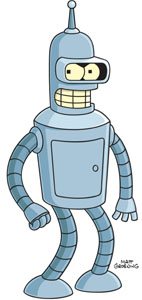 Yes, Stewie created his share on bots on Family Guy, including a robot best friend to replace Brian (who quickly creates his own robot best friends and abandons Stewie after accelerating past his inventor’s level of intelligence), and a robot duplicate of Peter, complete with a voice translation unit to transform Stewie’s eloquent speech through a microphone into the vulgar, uneducated banter of his dad. But this is a “family” website, and so we’ll avoid all the sordid motivations and details.
Yes, Stewie created his share on bots on Family Guy, including a robot best friend to replace Brian (who quickly creates his own robot best friends and abandons Stewie after accelerating past his inventor’s level of intelligence), and a robot duplicate of Peter, complete with a voice translation unit to transform Stewie’s eloquent speech through a microphone into the vulgar, uneducated banter of his dad. But this is a “family” website, and so we’ll avoid all the sordid motivations and details.
Matt Groening saved his best robots for Futurama, a series that was so populated with robots, a comprehensive coverage of its episodes on the subject is impossible. Principal among them was Bender, the wise-cracking, alcohol-fueled, cylinder-bodied silver robot who befriended Fry and became a work-shirking team member of Planet Express, after leaving his intended function of bending steel bars. He was part of a varied robot community, often at loggerheads with the human race, which included a robot mafia (including one “Clamps”, a robot named for such appendages in place of hands to perform a vice-grip on any foe), Fem-bots (females of the species, sometimes so alluring thar one episode is entirely devoted to Fry becoming obsessed with having one for his girlfriend instead of a human), a demented robot Santa (whose programming has malfunctioned to declare everyone “naughty”, transforming the holiday into the dreaded “Xmas” where the population goes into hiding in bunkers to avoid his homicidal aerial attacks), a Hedonism-bot (whose body design places him in permanent recline atop a built-in couch, appearing like a Roman emperor ready for some slave girl to pop grapes into his mouth), and Tinny Tim (an unfortunate robot waif who mirrors Tiny Tim from the Charles Dickens’ classic).
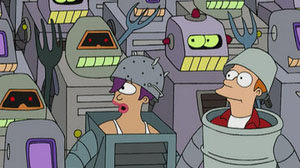 A highlight of the series was a visit to another world where robots have taken over entirely, entitled Fear of a Bot Planet (4/20/99). Planet Express receives an assignment to deliver a package to Chapex 9 – a planet colonized centuries ago by murderous robotic separatists. Today, the planet is entirely uninhabited – except for robots, who pride themselves in conducting daily human hunts (always without success) and operate under orders to destroy humans on sight. Leela (a cyclops) asks how they feel about humanoid aliens like herself. Professor Farnsworth replies, “They’re not fans.” The task of actually depositing the package on the planet thus falls upon the metal shoulders of Bender, who is already in a huff over his belief that humans have as much regard for robots as they do for toasters. Leela and Fry wait in the ship and lower Bender on a platform to the planet surface. After a considerable wait, a garbled communication is received from Bender, indicating he’s in trouble because they discovered he works for humans. The signal breaks up with a last view of Bender being carried away by two robot sentinels. Leela and Fry are forced to improvise a rescue. Grabbing every spare metal object the can find in the ship, they create makeshift robot costumes, and descend to the world below.
A highlight of the series was a visit to another world where robots have taken over entirely, entitled Fear of a Bot Planet (4/20/99). Planet Express receives an assignment to deliver a package to Chapex 9 – a planet colonized centuries ago by murderous robotic separatists. Today, the planet is entirely uninhabited – except for robots, who pride themselves in conducting daily human hunts (always without success) and operate under orders to destroy humans on sight. Leela (a cyclops) asks how they feel about humanoid aliens like herself. Professor Farnsworth replies, “They’re not fans.” The task of actually depositing the package on the planet thus falls upon the metal shoulders of Bender, who is already in a huff over his belief that humans have as much regard for robots as they do for toasters. Leela and Fry wait in the ship and lower Bender on a platform to the planet surface. After a considerable wait, a garbled communication is received from Bender, indicating he’s in trouble because they discovered he works for humans. The signal breaks up with a last view of Bender being carried away by two robot sentinels. Leela and Fry are forced to improvise a rescue. Grabbing every spare metal object the can find in the ship, they create makeshift robot costumes, and descend to the world below.
 They attempt to mingle as best they can (claiming to be looking forward to a romantic evening of “performing mindless repetitive tasks”), but Fry is spotted taking a whiz behind some trash cans, which a passing robot views as “leaking coolant at an alarming rate”. A clever sequence has them hide out in a movie theater, where a robot audience watches in terror a mock-1950’s sci-fi flick about an invading human from outer space (badly portrayed by a robot), set upon devouring the robot world with his internal organs. (Leela complains that her 3-D glasses “aren’t working” – is this any surprise, with her one eye?) They eventually locate Bender, who, to their amazement, is now not a prisoner at all, but a public guest of honor at an anti-human rally. To save his own tin, Bender has publicly renounced the humans, claiming to have personally killed a million billion humans on Earth. Leela and Fry wait their chance during the evening’s human hunt, and reveal their identities to Bender, attempting to bring him back to the ship. But Bender doesn’t want to be rescued. “I have wealth, fame, and access to the depths of sleaze that those things bring.” The robots roll into this scene, and Bender, to save his image, fakes a capture of the two intruders as prisoners. A trial commences before a computer monitor bearing a digitalized face resembling a metallic elderly judge. While Leela and Fry watch from a holding cell, the Mayor acts as prosecutor, declaring he will prove beyond 0.5 percent of a doubt that the humans are guilty of the crime of – being humans. Realizing the charges are self-proving, (though Leela objects that her one eye should be a disqualifying factor), the Mayor immediately rests his case. “I will now consider the evidence”, says the digital judge, as the screen displays a Microsoft-style progress bar, registering percentage completion of the process of “Judging”. Of course, the screen freezes in mid-function, with various spectators from the gallery shouting, “Try control + alt + delete”, “Jiggle the cord”, “Turn him off and on”, “Clean the gunk out of the mouse”, and even Fry chiming in, “Call technical support”.
They attempt to mingle as best they can (claiming to be looking forward to a romantic evening of “performing mindless repetitive tasks”), but Fry is spotted taking a whiz behind some trash cans, which a passing robot views as “leaking coolant at an alarming rate”. A clever sequence has them hide out in a movie theater, where a robot audience watches in terror a mock-1950’s sci-fi flick about an invading human from outer space (badly portrayed by a robot), set upon devouring the robot world with his internal organs. (Leela complains that her 3-D glasses “aren’t working” – is this any surprise, with her one eye?) They eventually locate Bender, who, to their amazement, is now not a prisoner at all, but a public guest of honor at an anti-human rally. To save his own tin, Bender has publicly renounced the humans, claiming to have personally killed a million billion humans on Earth. Leela and Fry wait their chance during the evening’s human hunt, and reveal their identities to Bender, attempting to bring him back to the ship. But Bender doesn’t want to be rescued. “I have wealth, fame, and access to the depths of sleaze that those things bring.” The robots roll into this scene, and Bender, to save his image, fakes a capture of the two intruders as prisoners. A trial commences before a computer monitor bearing a digitalized face resembling a metallic elderly judge. While Leela and Fry watch from a holding cell, the Mayor acts as prosecutor, declaring he will prove beyond 0.5 percent of a doubt that the humans are guilty of the crime of – being humans. Realizing the charges are self-proving, (though Leela objects that her one eye should be a disqualifying factor), the Mayor immediately rests his case. “I will now consider the evidence”, says the digital judge, as the screen displays a Microsoft-style progress bar, registering percentage completion of the process of “Judging”. Of course, the screen freezes in mid-function, with various spectators from the gallery shouting, “Try control + alt + delete”, “Jiggle the cord”, “Turn him off and on”, “Clean the gunk out of the mouse”, and even Fry chiming in, “Call technical support”.
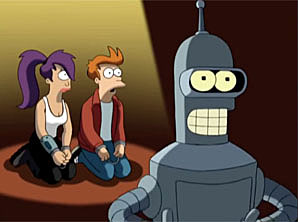 The judge comes back on line, decreeing the prisoners guilty. They are sentenced to live like robots do on Earth – doomed to perform tedious calculations, and spot-weld automobiles, until they become obsolete and are given away to an inner-city middle school. A trap door drops the prisoners down a chute to another chamber hidden deep below the planet surface, where they receive a new surprise verdict by a panel of robot elders who are the real rulers of the planet – immediate death. Who is called upon to perform the task but Bender. Bender attempts to follow through, but relents and realizes he can’t betray his friends. Bender intercedes on their behalf, informing the elders that humans are really harmless. The elders already know, but insist they too must keep up a front of human hatred to keep the populace’s electronic minds off more pressing problems at hand, such as their critical shortage of lug nuts. As all three of the visitors now know too much, the elders shift into kill mode. But Fry bluffs, claiming he will breathe fire upon them, and the three escape while the elders debate whether humans really have that power or whether the elders themselves made that up. As the robots pursue, Bender, Leela and Fry hop aboard the platform to lift them back into the ship. The pursuing robots begin stacking themselves one atop another to give chase. At this critical moment, Bender remembers that he never did deliver the package, and tosses it to the top robot on the totem pole. The extra weight topples the column, sending the bots and the package crashing back to the planet. As the package cracks open, a shower of a precious commodity rains upon the populace – lug nuts! The intruders are hailed as heroes by emphatic cries from the planet, while Leela, Fry and Bender renew friendships with a party thrown in Bender’s honor – for a robot holiday (Robanukah) that Bender made up entirely just to get out of work.
The judge comes back on line, decreeing the prisoners guilty. They are sentenced to live like robots do on Earth – doomed to perform tedious calculations, and spot-weld automobiles, until they become obsolete and are given away to an inner-city middle school. A trap door drops the prisoners down a chute to another chamber hidden deep below the planet surface, where they receive a new surprise verdict by a panel of robot elders who are the real rulers of the planet – immediate death. Who is called upon to perform the task but Bender. Bender attempts to follow through, but relents and realizes he can’t betray his friends. Bender intercedes on their behalf, informing the elders that humans are really harmless. The elders already know, but insist they too must keep up a front of human hatred to keep the populace’s electronic minds off more pressing problems at hand, such as their critical shortage of lug nuts. As all three of the visitors now know too much, the elders shift into kill mode. But Fry bluffs, claiming he will breathe fire upon them, and the three escape while the elders debate whether humans really have that power or whether the elders themselves made that up. As the robots pursue, Bender, Leela and Fry hop aboard the platform to lift them back into the ship. The pursuing robots begin stacking themselves one atop another to give chase. At this critical moment, Bender remembers that he never did deliver the package, and tosses it to the top robot on the totem pole. The extra weight topples the column, sending the bots and the package crashing back to the planet. As the package cracks open, a shower of a precious commodity rains upon the populace – lug nuts! The intruders are hailed as heroes by emphatic cries from the planet, while Leela, Fry and Bender renew friendships with a party thrown in Bender’s honor – for a robot holiday (Robanukah) that Bender made up entirely just to get out of work.
Here it is – ‘flipped’ for your viewing displeasure.
More odds and ends next week, with a primary focus on W-B and Cartoon Network.
